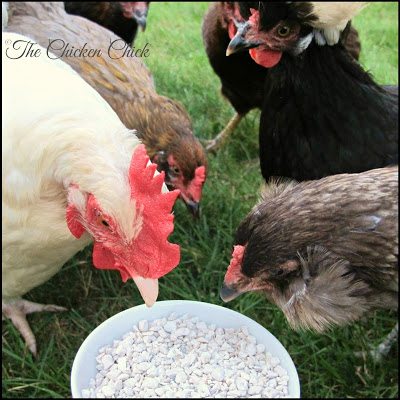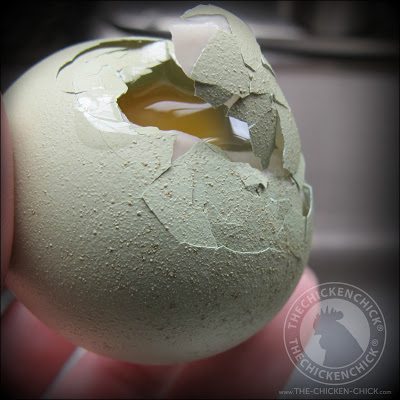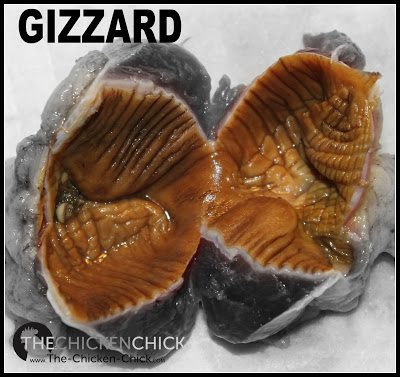Chickens and humans share a few things in common: what we eat impacts how we feel and how our bodies perform. As anyone who has struggled with fertility issues knows, diet affects egg production and egg quality. Similarly, a hen's egg production is affected by diet. However, hens are much more sensitive to getting their daily nutritional needs met than women, in part because hens make eggs each month, not just one.
Hens require precise amounts of each essential dietary component, in the right forms and at the right times to live long, healthy lives and make high-quality, normal looking eggs.One of the most important nutrients needed for eggshell formation is calcium. Most of us understand that laying hens need calcium to make eggshells and realize that commercially produced layer feed contains some calcium, but it may not be clear why providing oyster shells, a second source of calcium, is beneficial to laying hens. So let's take a deeper look into why oyster shell is used in laying hen diets.
I had the chance to speak at length with two seasoned poultry nutritionists, Dr. Gordon Ballam and Dr. Patrick Biggs about this whole calcium thing and I've got the Cliff Notes version of the calcium story for you!
LAYING HENS NEED CALCIUM AT THE RIGHT TIME
To make eggshells, laying hens require 4-5 grams of calcium per day,[1] which is three times more dietary calcium than non-laying hens, according to Dr. Biggs.
Eggshells are composed of 94% calcium carbonate[1] and hens cannot make calcium, so it must be supplied in their diet. The most common sources of calcium carbonate fed to laying hens are crushed limestone and oyster shell. Commercially prepared layer feeds ordinarily contain limestone, while oyster shell is usually offered to hens by chicken keepers as a supplement to the layer feed.
Laying hens store calcium in specialized bones called medullary bones. Think: sponge-like bone filled with calcium inside a hard, hollow bone. (The hard bone is the cortical bone, which is responsible for strength and stability).
Calcium carbonate must be broken down into its components (calcium + carbonate) in the hen's intestine before the calcium is absorbed into the blood. The calcium is then either stored in the bones or routed directly to the shell gland through the bloodstream. If laying hens don't get calcium when they need it, they will steal from the calcium stash inside their cortical bones to produce eggshells. This calcium theft can cause brittle bones that fracture easily and in the most severe cases, the inability to stand (aka: caged-layer fatigue).
TWO TYPES OF DIETARY CALCIUM
There are two types of calcium ordinarily fed to backyard laying hens: crushed limestone, which layer feed already contains, and oyster shell, which we ordinarily offer to them in a dispenser or dish near their feeder. Crushed limestone can be thought of as a fast-release source of calcium because it's small and is absorbed easily and quickly by the hen. Oyster shell is more of a slow-release source of calcium because it is large and sits in the gizzard, getting ground up a little at a time before being absorbed by the hen. A form of slow-release calcium is important because eggshells are formed at night when the hen is asleep, not consuming calcium-containing feed.
The time it takes for most food particles to pass through a chicken is very short – about 90 minutes. Bigger particles take longer to pass through a hen, which is why providing oyster shell during the day can help to provide more calcium at night. A slow-release calcium takes much longer to breakdown, supplying the hen with calcium throughout the night.
The gizzard is a muscle in a chicken's digestive tract responsible for grinding fibrous food with the help of grit (sand/stones/oyster shells, etc.)
WE THOUGHT SHE WAS JUST SLEEPING AT NIGHT!
Of the approximately 25 hours needed to create an egg, 18-20 of them are dedicated to shell formation, which occurs overnight while a hen sleeps. A hen can use and replace the calcium it carries in her bloodstream up to 100 times overnight! #mindblown
Since hens sleep at night, if the last feed they eat for the day is on the droppings board within 90 minutes after lights out, where does all the calcium for eggshell formation come from? #lightbulbmoment The large particles of oyster shell in the gizzard are essential to eggshell formation overnight!
SUPPLEMENTAL CALCIUM
Always offer laying hens a separate dish of oyster shells, but do not mix it into their feed. Each hen will ingest more or less oyster shells to meet her individual calcium needs as necessary. Learn why all hens require more oyster shell in hot weather HERE.
SKIP THE CRUSHED EGGSHELLS!
Before the advent of commercially available, nutritionally complete chicken feed, farmers would offer crushed eggshells to their laying hens to provide a fast-release source of calcium to laying hens to support bone strength and eggshell quality. However, because nutritionally complete chicken feeds already contain crushed limestone, a fast-release, small particle size source of calcium, eggshells are unnecessary and redundant. Crushed eggshells are neither necessary, nor helpful to laying hens as the excess calcium must be filtered out of the hen's body, taxing her kidneys. Skip the crushed eggshells.
Kathy Shea Mormino
Affectionately known internationally as The Chicken Chick®, Kathy Shea Mormino shares a fun-loving, informative style to raising backyard chickens. …Read on


shop my SPONSORS
Chickens and humans share a few things in common: what we eat impacts how we feel and how our bodies perform. As anyone who has struggled with fertility issues knows, diet affects egg production and egg quality. Similarly, a hen's egg production is affected by diet. However, hens are much more sensitive to getting their daily nutritional needs met than women, in part because hens make eggs each month, not just one.
Hens require precise amounts of each essential dietary component, in the right forms and at the right times to live long, healthy lives and make high-quality, normal looking eggs.One of the most important nutrients needed for eggshell formation is calcium. Most of us understand that laying hens need calcium to make eggshells and realize that commercially produced layer feed contains some calcium, but it may not be clear why providing oyster shells, a second source of calcium, is beneficial to laying hens. So let's take a deeper look into why oyster shell is used in laying hen diets.
I had the chance to speak at length with two seasoned poultry nutritionists, Dr. Gordon Ballam and Dr. Patrick Biggs about this whole calcium thing and I've got the Cliff Notes version of the calcium story for you!
LAYING HENS NEED CALCIUM AT THE RIGHT TIME
To make eggshells, laying hens require 4-5 grams of calcium per day,[1] which is three times more dietary calcium than non-laying hens, according to Dr. Biggs.
Eggshells are composed of 94% calcium carbonate[1] and hens cannot make calcium, so it must be supplied in their diet. The most common sources of calcium carbonate fed to laying hens are crushed limestone and oyster shell. Commercially prepared layer feeds ordinarily contain limestone, while oyster shell is usually offered to hens by chicken keepers as a supplement to the layer feed.
Laying hens store calcium in specialized bones called medullary bones. Think: sponge-like bone filled with calcium inside a hard, hollow bone. (The hard bone is the cortical bone, which is responsible for strength and stability).
Calcium carbonate must be broken down into its components (calcium + carbonate) in the hen's intestine before the calcium is absorbed into the blood. The calcium is then either stored in the bones or routed directly to the shell gland through the bloodstream. If laying hens don't get calcium when they need it, they will steal from the calcium stash inside their cortical bones to produce eggshells. This calcium theft can cause brittle bones that fracture easily and in the most severe cases, the inability to stand (aka: caged-layer fatigue).
TWO TYPES OF DIETARY CALCIUM
There are two types of calcium ordinarily fed to backyard laying hens: crushed limestone, which layer feed already contains, and oyster shell, which we ordinarily offer to them in a dispenser or dish near their feeder. Crushed limestone can be thought of as a fast-release source of calcium because it's small and is absorbed easily and quickly by the hen. Oyster shell is more of a slow-release source of calcium because it is large and sits in the gizzard, getting ground up a little at a time before being absorbed by the hen. A form of slow-release calcium is important because eggshells are formed at night when the hen is asleep, not consuming calcium-containing feed.
The time it takes for most food particles to pass through a chicken is very short – about 90 minutes. Bigger particles take longer to pass through a hen, which is why providing oyster shell during the day can help to provide more calcium at night. A slow-release calcium takes much longer to breakdown, supplying the hen with calcium throughout the night.
The gizzard is a muscle in a chicken's digestive tract responsible for grinding fibrous food with the help of grit (sand/stones/oyster shells, etc.)
WE THOUGHT SHE WAS JUST SLEEPING AT NIGHT!
Of the approximately 25 hours needed to create an egg, 18-20 of them are dedicated to shell formation, which occurs overnight while a hen sleeps. A hen can use and replace the calcium it carries in her bloodstream up to 100 times overnight! #mindblown
Since hens sleep at night, if the last feed they eat for the day is on the droppings board within 90 minutes after lights out, where does all the calcium for eggshell formation come from? #lightbulbmoment The large particles of oyster shell in the gizzard are essential to eggshell formation overnight!
SUPPLEMENTAL CALCIUM
Always offer laying hens a separate dish of oyster shells, but do not mix it into their feed. Each hen will ingest more or less oyster shells to meet her individual calcium needs as necessary. Learn why all hens require more oyster shell in hot weather HERE.
SKIP THE CRUSHED EGGSHELLS!
Before the advent of commercially available, nutritionally complete chicken feed, farmers would offer crushed eggshells to their laying hens to provide a fast-release source of calcium to laying hens to support bone strength and eggshell quality. However, because nutritionally complete chicken feeds already contain crushed limestone, a fast-release, small particle size source of calcium, eggshells are unnecessary and redundant. Crushed eggshells are neither necessary, nor helpful to laying hens as the excess calcium must be filtered out of the hen's body, taxing her kidneys. Skip the crushed eggshells.





































Helpful and fun article! I want to run out and buy Oyster Shells and Spruce the Coop!
i have started a garden this year as well as my ladies and planted some veges just to feed them. are there any you would recommend? I loved the coop herbs idea what is an there that would be great for them.
Thanks Susan. Three months is too young. Wait until they’re 18 weeks old to switch to layer feed and oyster shell free-choice.
My girls are about 3 mos old and I’m just starting them on oyster shell. Hope this is the right time to start. Great info as always!!
The spruce the coop! Also what do you use to line your nesting boxes for easier cleaning?